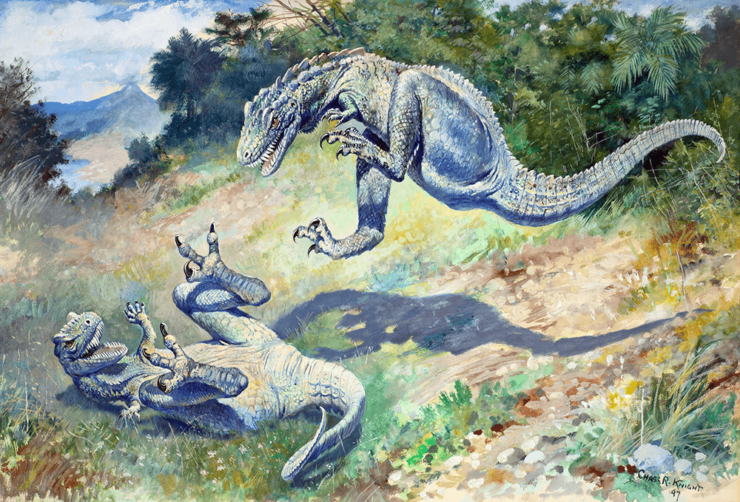SF writers frequently send their protagonists back in time. Quite often, they send their characters to a time when said characters might be stalked by a dinosaur. If sent to an even earlier time, characters might be menaced by a Gorgonopsid (though I am unaware of any such excursions; perhaps someone needs to write one). The earliest fauna that might endanger protagonists would have to be Cambrian. Perhaps a swarm of ferocious thirty-centimeter Peytoia nathorsti?
Ah, the Cambrian. 541 million years ago. Brings back memories. Not that I was there, mind you. Memories, rather, of the olden days when we believed that the Cambrian Explosion was the very fons et origo of complex life. Now we know that while the Cambrian Explosion was definitely a significant event, it doesn’t seem to have been the only time the planet dabbled with complex life vaguely analogous to modern forms.
The Ediacaran (635 million to 541 million years ago) also featured a diverse array of… squishy things… whose relationship to modern life forms is unclear. Who knows? If careless time travellers had stepped on different animals 541 million years ago, the Earth’s surface might be dominated by…larger but still squishy things, rather than our marvellous selves.
Still, the Earth is 4.5 billion years old. At the beginning of the Ediacaran, the Earth was 86% as old as it is now, while at the beginning of the Cambrian it was 88% as old as it is now. Both experiments in complex life are recent. So perhaps Earth wasn’t ready for complex life?
Perhaps it was. There’s a third might-be-complex life form known as the Francevillian biota. It dates back an astounding 2.1 billion years, when the Earth was roughly half its current age. While it’s true that none of the organisms preserved in the Gabon fossil bed are likely to get their own blockbuster film, being roughly the size and shape of a urinal puck, still: 2.1 billion years! It is also not clear if these were complex life forms or something more like a microbial mat.
Except… as pointed out in email by William Baird, of The Dragon’s Tales:
Organism motility in an oxygenated shallow-marine environment 2.1 billion years ago reports an astounding find:
…string-shaped structures are up to 6 mm across and extend up to 170 mm through the strata. Morphological and 3D tomographic reconstructions suggest that the producer may have been a multicellular or syncytial organism able to migrate laterally and vertically to reach food resources.
So, something may have been stomping (or oozing) around on Earth back when it was only about half as old as it was today. What the relationship between it and us might have been, who knows? But it was huge—at least if you take into account that humans are giants as terrestrial lifeforms go.
Happily for us, that little experiment seems to have gone nowhere, which means that no eerily-alien-but-fully-terrestrial civilization arose to transform the planet and reshape the solar system long before we decided to tackle the job ourselves. Well, as far as we know….
I’m pretty sure if a civilization had popped up in the Silurian there would be clear indications in the geological record. Two billion-plus years is long enough for whole continents to rise and fall; for continental plates to be subducted into ocean trenches and be recycled as magma.
If there were complex life forms oozing here and there, where might they have gone? And why? Hard to say. The O2 fraction of the atmosphere seems to have dropped off, which cannot have been great for anything trying to fuel a high-grade metabolism. But Baird suggests in private communication that maybe it’s not a complete coincidence that the Vredefort crater,the largest verified impact crater on Earth, and Sudbury, the third largest impact crater on Earth, date to 2.02 and 1.85 billion years ago, respectively.
Are these the smoking guns?
Alas, poor Francevillian biota. We knew ye not.
In the words of Wikipedia editor TexasAndroid, prolific book reviewer and perennial Darwin Award nominee James Davis Nicoll is of “questionable notability.” His work has appeared in Publishers Weekly and Romantic Times as well as on his own websites, James Nicoll Reviews and Young People Read Old SFF (where he is assisted by editor Karen Lofstrom and web person Adrienne L. Travis). He is surprisingly flammable.










